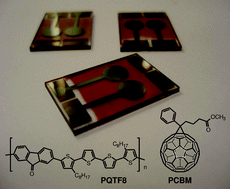Conjugated alternating copolymer of dialkylquaterthiophene and fluorenone: synthesis, characterisation and photovoltaic properties†
Abstract
New π-conjugated alternating copolymers containing thienylene and

* Corresponding authors
a
Laboratoire d'Electronique Moléculaire Organique et Hybride (LEMOH), UMR5819-SPrAM (CEA-CNRS-Univ.Grenoble I), DRFMC CEA-Grenoble, 17 rue des Martyrs 38054 Grenoble Cedex 9, France
E-mail:
renaud.demadrille@cea.fr
Fax: +33-(0)4-3878-5113
Tel: +33-(0)4-3878-4484
b Laboratoire Cellules Solaires, DRT-LITEN-GENEC-LCS, CEA-Saclay, 91191 Gif sur Yvette Cedex, France
New π-conjugated alternating copolymers containing thienylene and

 Please wait while we load your content...
Something went wrong. Try again?
Please wait while we load your content...
Something went wrong. Try again?
R. Demadrille, N. Delbosc, Y. Kervella, M. Firon, R. De Bettignies, M. Billon, P. Rannou and A. Pron, J. Mater. Chem., 2007, 17, 4661 DOI: 10.1039/B708372F
To request permission to reproduce material from this article, please go to the Copyright Clearance Center request page.
If you are an author contributing to an RSC publication, you do not need to request permission provided correct acknowledgement is given.
If you are the author of this article, you do not need to request permission to reproduce figures and diagrams provided correct acknowledgement is given. If you want to reproduce the whole article in a third-party publication (excluding your thesis/dissertation for which permission is not required) please go to the Copyright Clearance Center request page.
Read more about how to correctly acknowledge RSC content.
 Fetching data from CrossRef.
Fetching data from CrossRef.
This may take some time to load.
Loading related content
